Welcome to the ultimate guide for creating a vibrant, flavorful, and incredibly easy Teriyaki Stir Fry Vegetables Recipe that will quickly become a favorite in your kitchen. Forget about expensive, often unhealthy takeout; this homemade stir-fry is not only budget-friendly and packed with nutrients but also ready to serve in under 30 minutes. Whether you’re a seasoned chef or just starting your culinary journey, these vegan stir-fry veggies coated in a rich, savory teriyaki sauce are perfect for a satisfying weeknight dinner or a delightful side dish that bursts with flavor and color.

Why You’ll Love This Easy Stir Fry
This Teriyaki Stir Fry isn’t just a meal; it’s a culinary experience designed for convenience, health, and incredible taste. Here’s why this recipe will quickly become a staple in your meal rotation:
- Effortless Weeknight Solution: When the eternal question “What’s for dinner?” arises, this stir-fry offers a delightfully simple and quick answer. It’s perfect for those busy evenings when you need a delicious meal on the table without a lot of fuss.
- Flexible with Ingredients: This recipe embraces flexibility! You can utilize whatever fresh vegetables you have on hand or conveniently reach for a bag of frozen veggies. It’s an excellent way to reduce food waste and adapt to your schedule.
- Customizable to Your Taste: The beauty of stir-frying lies in its adaptability. This recipe works wonderfully with *your* favorite vegetables, allowing you to create a dish that perfectly suits your preferences and dietary needs.
- Incredibly Flavorful and Satisfying: Coated in our rich, homemade teriyaki sauce, these vegetables are far from bland. Each bite is savory, slightly sweet, and deeply satisfying, proving that healthy eating can be incredibly delicious.
- Blazing Fast Prep and Cook Time: From chopping to serving, this entire dish can be ready in under 30 minutes. This makes it an ideal choice for busy individuals and families who don’t want to compromise on taste or nutrition.
- Healthier Homemade Teriyaki Sauce: By making your own teriyaki sauce, you gain complete control over the ingredients, allowing you to avoid excessive sodium, sugar, and artificial additives often found in store-bought versions. This results in a fresher, healthier, and more vibrant flavor.
- Perfect for Meal Prep: This stir fry reheats beautifully, making it an excellent candidate for meal prepping. Enjoy wholesome, flavorful lunches or dinners throughout the week.
- Nutrient-Packed: Loaded with a variety of colorful vegetables, this stir-fry is a powerhouse of vitamins, minerals, and fiber, contributing to a balanced and healthy diet.
Homemade Vegan Teriyaki Sauce Ingredients
Crafting your own teriyaki sauce from scratch not only saves money but also ensures a much healthier and more flavorful result compared to most store-bought options. This vegan version is free from animal products and brimming with fresh, balanced tastes.
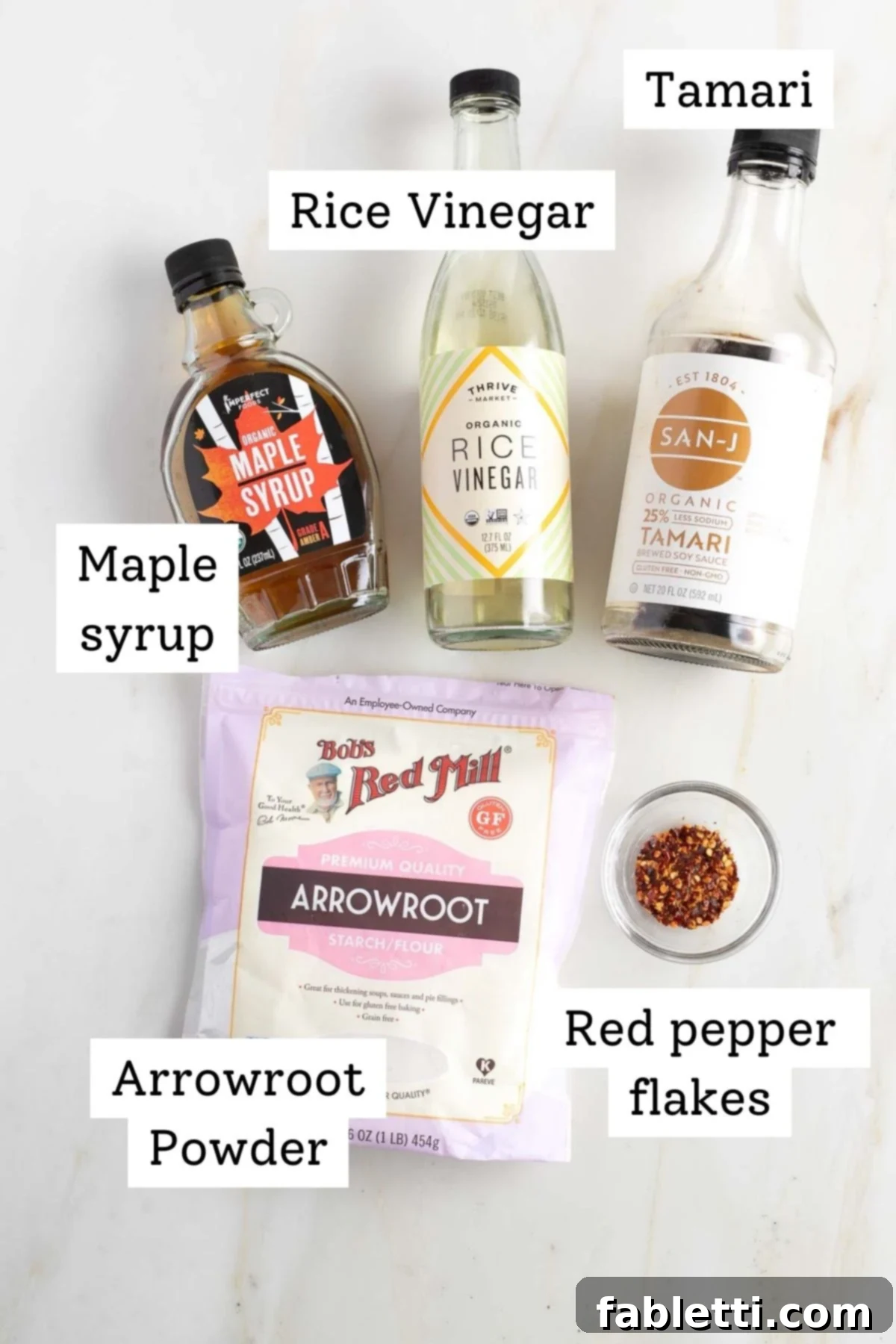
- Tamari: This is our preferred gluten-free alternative to traditional soy sauce. It provides the essential savory, umami base for the sauce. Opt for a reduced-sodium variety to better control the saltiness of your dish. If gluten isn’t a concern, regular low-sodium soy sauce can be used.
- Rice Vinegar: Unsweetened rice wine vinegar is crucial for balancing the sweetness of the maple syrup and adding a subtle tang that brightens the overall flavor profile of this homemade sauce. If you don’t have it, white vinegar, apple cider vinegar, or a squeeze of fresh lemon juice can work as a substitute, though they may alter the flavor slightly.
- Maple Syrup: We use maple syrup as a natural, unrefined sweetener. It’s a healthier and delicious alternative to brown sugar, which is commonly found in many traditional stir-fry recipes. Agave nectar can also be used if maple syrup is unavailable.
- Arrowroot Powder: This natural starch is an excellent choice for thickening the sauce, providing a glossy finish without the potential graininess sometimes associated with cornstarch. It’s also gluten-free and generally considered easier to digest. Mix it with a small amount of cold water to create a “slurry” before adding it to the hot sauce to prevent clumps.
- Red Pepper Flakes: For those who appreciate a hint of heat, red pepper flakes are a fantastic addition. They introduce a gentle warmth that complements the other flavors without overpowering them. If you prefer a stronger spice kick, a dash of sriracha or a pinch of finely minced fresh chili can be incorporated.
Are Fresh or Frozen Vegetables Better?
One of the true beauties of a stir-fry is its incredible versatility, particularly when it comes to choosing your vegetables. You can confidently use either fresh or frozen veggies, and both options offer distinct advantages depending on your needs and preferences.
Let’s debunk a common misconception: a bag of frozen vegetables, especially those that are “flash-frozen” at the peak of their ripeness, can often be just as, if not more, nutritious than fresh produce. This is because fresh vegetables sometimes lose nutrients during transit and storage, whereas frozen ones are typically picked and processed very quickly, locking in their vitamins and minerals. When selecting frozen vegetables, always check the ingredient list to ensure the only ingredient is the vegetable itself—avoid anything with added sauces, seasonings, or excessive sodium.
For those with unpredictable schedules, frozen vegetables are a lifesaver. You might not always have the time or opportunity to visit the grocery store mid-week to replenish your fresh produce supply. Keeping a well-stocked freezer with a variety of vegetable medleys ensures that a simple, healthy teriyaki stir-fry is always a possibility on your meal plan. They offer unparalleled convenience, allowing you to get a wholesome dinner on the table any night without extensive prep.
However, fresh vegetables also bring their own unique qualities. They offer a crisper texture and a more vibrant, immediate flavor that can be particularly appealing. When using fresh, you have the freedom to select exactly what looks best and to custom-cut them to your desired size and shape. Just remember to wash and chop them all before you start cooking for a seamless stir-frying experience.
Ultimately, the “better” choice depends on your priorities: convenience and nutrient retention often favor frozen, while texture and specific ripeness might lean towards fresh. Don’t hesitate to mix and match! A combination of fresh and frozen can offer the best of both worlds.
Vegetable Stir Fry Ingredients
This recipe calls for a vibrant medley of vegetables, aromatics, and a touch of oil to create a truly irresistible stir-fry. The beauty here is customization – feel free to swap or add based on what you love and what’s available.
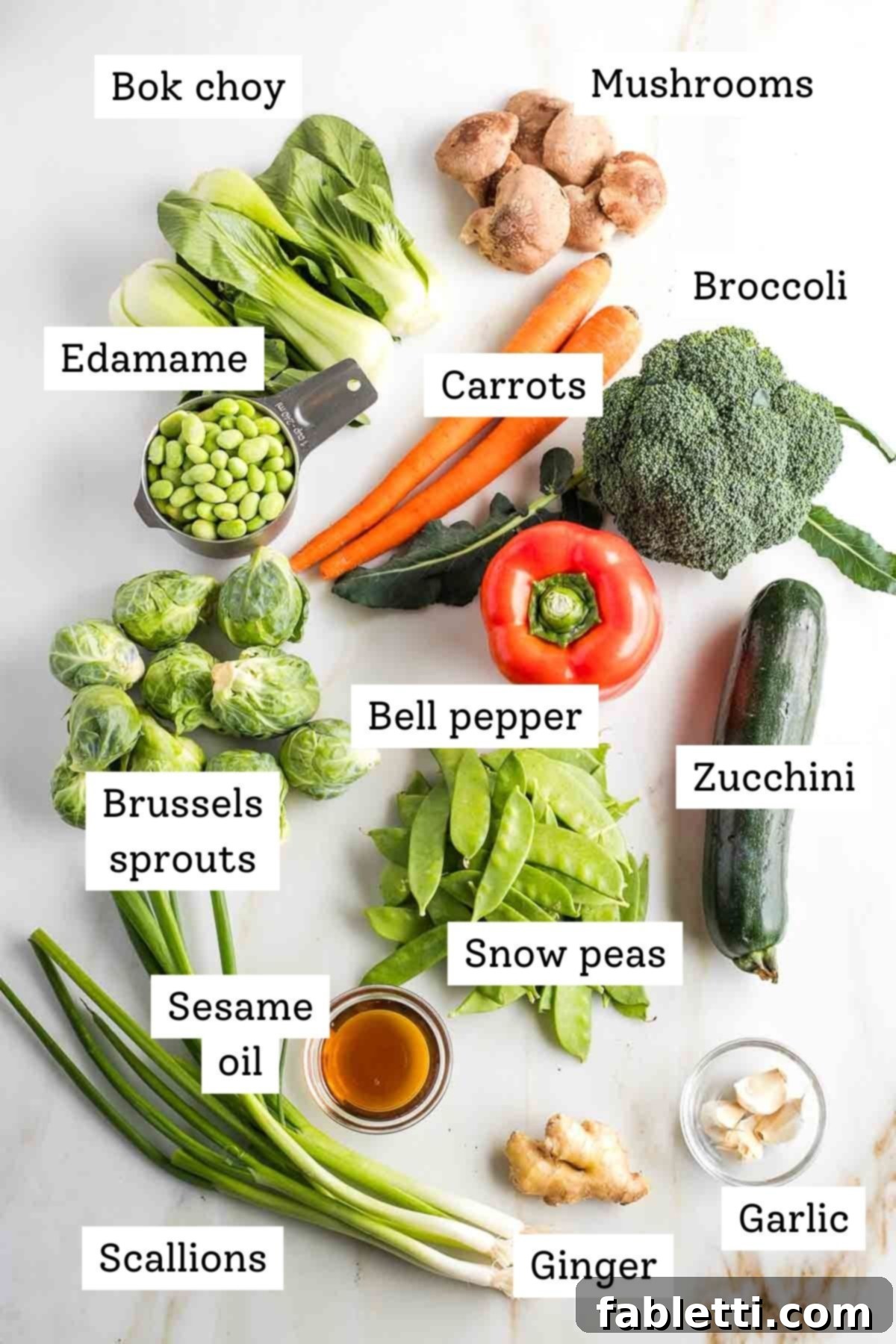
- Vegetables: You’ll need a total of approximately 5 cups of chopped vegetables. Our suggested combination for fantastic flavor and texture includes broccoli florets and stems, bok choy, shiitake mushrooms, crisp snow peas, vibrant red bell pepper, tender zucchini, hearty Brussels sprouts, and sweet carrots. Other excellent additions or substitutions include snap peas, green beans, cauliflower, asparagus, or even thinly sliced cabbage. The key is to use a balanced mix of harder vegetables (like carrots, broccoli stems, Brussels sprouts) that require a longer cooking time, and softer ones (like bell peppers, mushrooms, zucchini) that cook quickly.
- Edamame: Shelled edamame beans are a fantastic addition, providing a boost of plant-based protein and a pleasant texture. They can be added directly from the freezer to the stir-fry towards the end of cooking.
- Scallions: Also known as green onions or spring onions, scallions add a mild oniony flavor and a fresh, bright garnish. If you don’t have scallions, thinly sliced red onion or leeks can provide a similar aromatic quality.
- Garlic: Fresh garlic is indispensable for its pungent, aromatic flavor. If fresh garlic isn’t available, garlic powder can be used as a substitute, but be sure to use garlic powder, not garlic salt, to control the sodium content.
- Ginger: Nothing quite compares to the zesty, spicy, and fragrant punch of freshly grated ginger. It’s a cornerstone of Asian cuisine and truly elevates the stir-fry.
- Oil: Toasted sesame oil is highly recommended for its distinctive nutty aroma and flavor, which is characteristic of many Asian dishes. If you prefer a lighter taste, regular sesame oil, avocado oil, or even grapeseed oil can be used. A combination of toasted sesame oil for flavor and a neutral oil like avocado oil for high-heat cooking also works well. For an entirely oil-free stir-fry, you can sauté the vegetables in a splash of vegetable broth.
- Optional Garnishes and Additions: Elevate your finished teriyaki vegetable stir-fry with a sprinkle of toasted sesame seeds for crunch, additional thinly sliced scallions for freshness, and a pinch of crushed red pepper flakes for an extra kick. For added freshness and texture, toss in some bean sprouts just before serving.
How to Stir Fry Vegetables
Successful stir-frying hinges on proper preparation. Ensure all your fresh vegetables are washed, chopped into bite-sized pieces, and ready to go before you even turn on the stove. If using frozen vegetables, they can be added directly from the freezer to the hot pan.
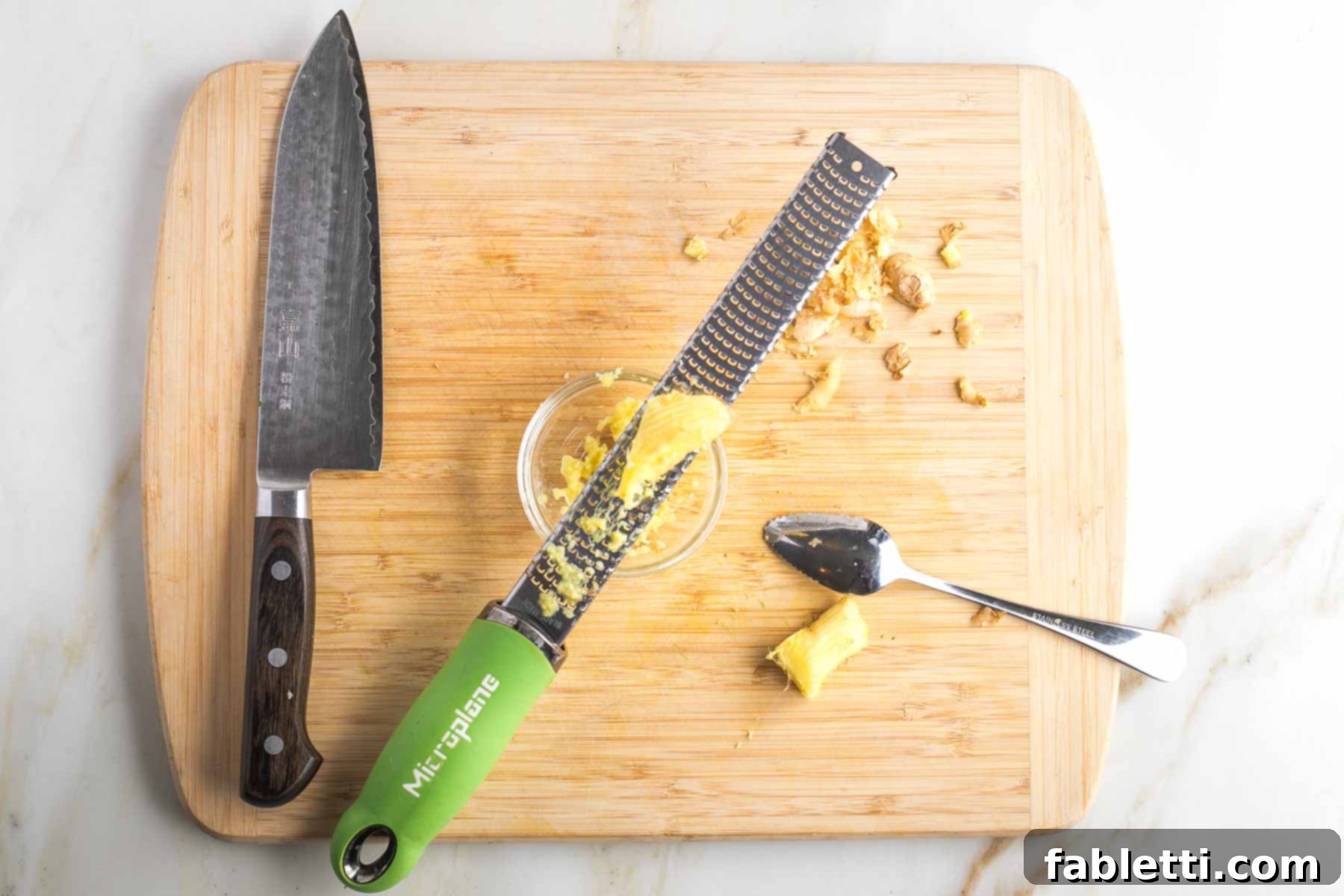
To prepare fresh ginger, use the edge of a spoon (a grapefruit spoon works perfectly) to easily scrape off the thin skin. Then, use a microplane grater to finely grate it into a bowl, or a sharp knife to peel and mince it very finely.

Peel your garlic cloves. For the best flavor distribution, finely grate them using a microplane, or alternatively, press them through a garlic press or mince them finely with a knife.
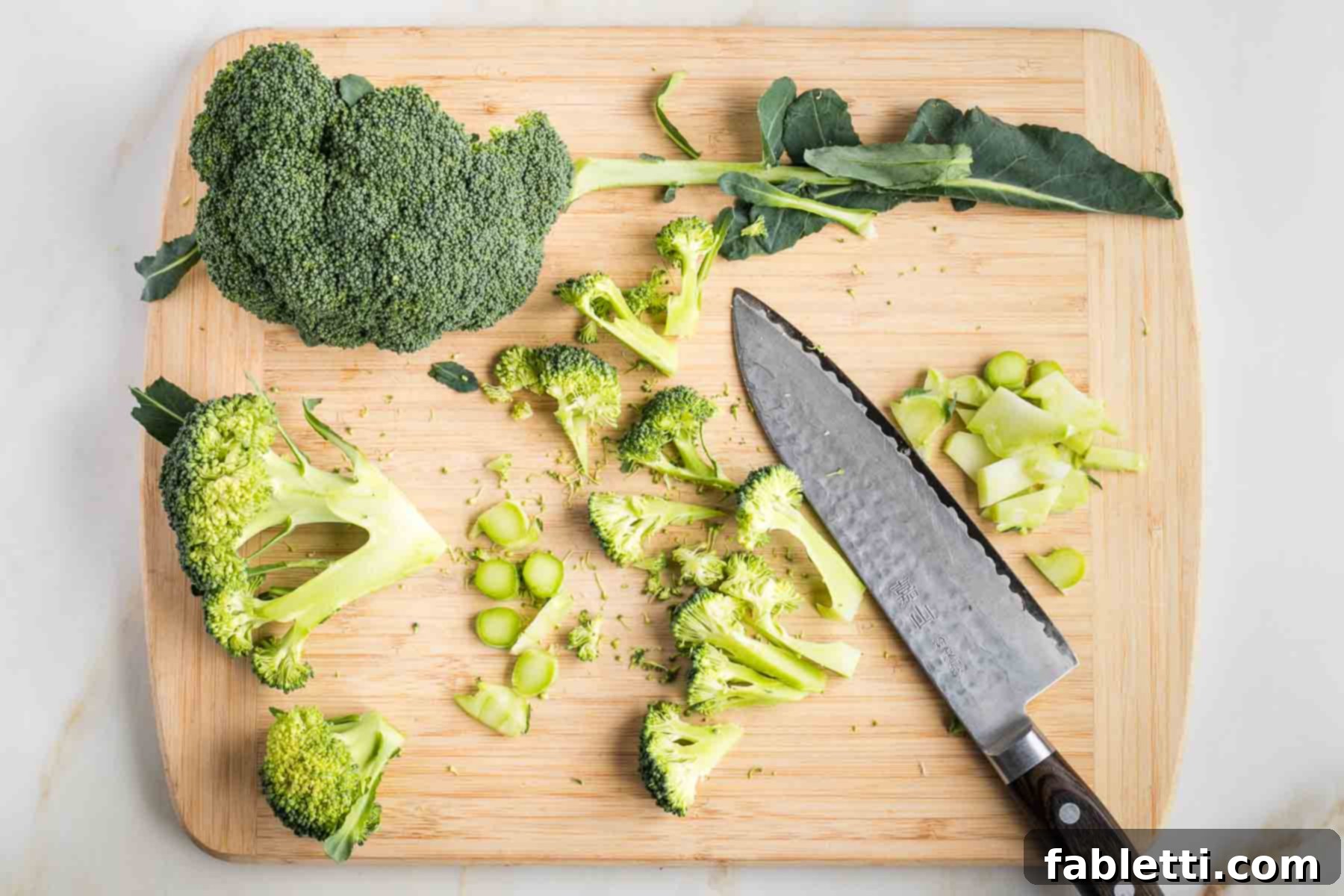
Chop each vegetable into uniform, bite-sized pieces to ensure even cooking. For broccoli, separate the florets from the stems, then cut the stems into thin discs and the florets into smaller, manageable pieces.
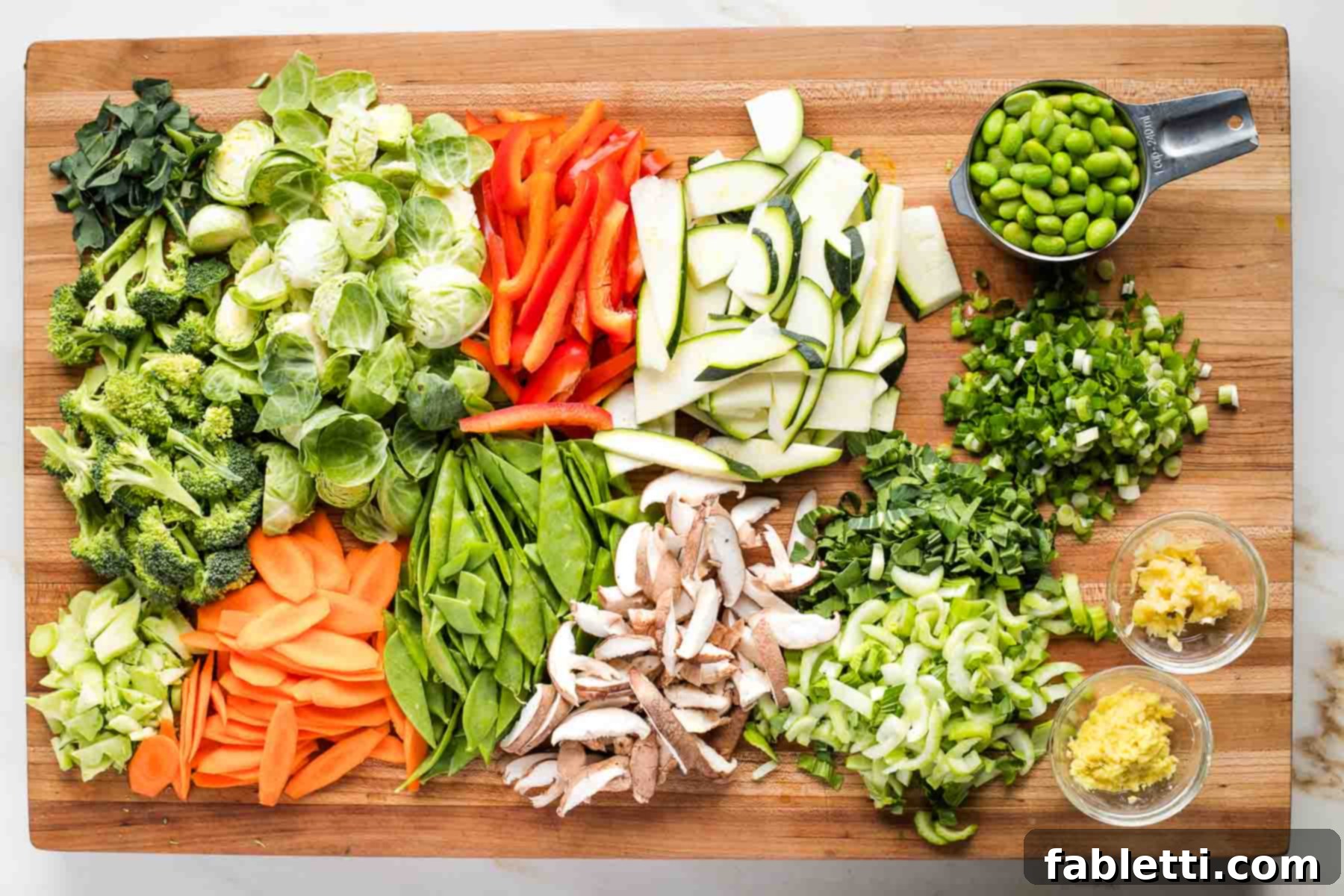
Arrange your prepped vegetables near the stove, organized by their cooking time. Harder vegetables that require longer to cook, such as carrots and broccoli stems, should be placed closest for easy access and added to the pan first.
Make the Teriyaki Sauce:
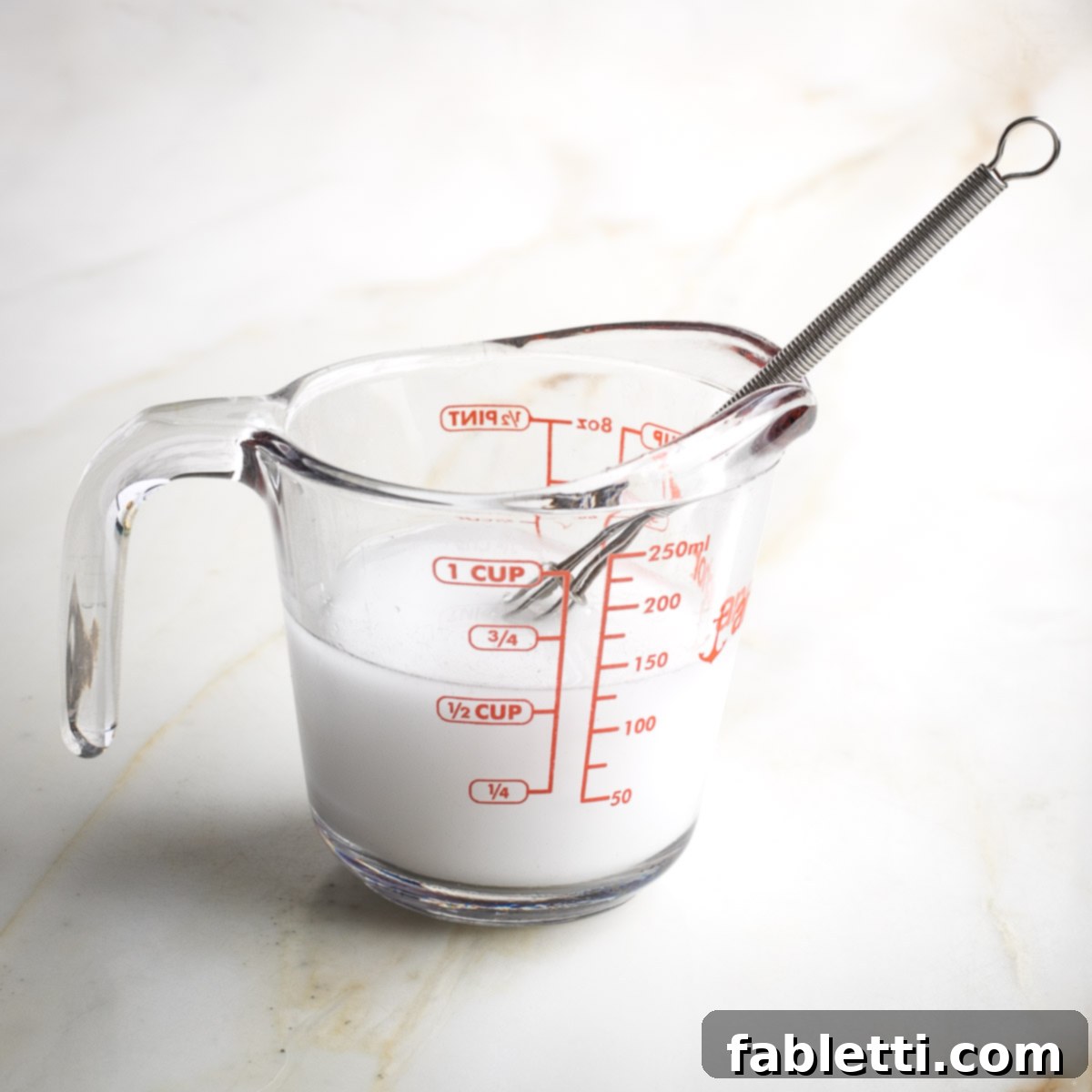
Begin by whisking the arrowroot powder with ½ cup of cold water in a small bowl until completely smooth to create a slurry. In a small saucepan, combine the tamari, maple syrup, and rice vinegar. Heat this mixture over medium heat. Once it begins to warm, whisk in the arrowroot slurry and the red pepper flakes. Continue to whisk constantly as the sauce comes to a gentle boil, then reduce the heat to low. Keep whisking until the sauce begins to visibly thicken, which should take about 3 minutes. Turn off the heat. The sauce will develop a beautiful sheen and continue to thicken as it cools. Set it aside while you prepare your vegetables.

Heat a large wok or your largest frying pan over high heat until it’s very hot. Swirl in half of the toasted sesame oil. Add your harder vegetables first—this typically includes carrots, quartered Brussels sprouts, and broccoli stems. Cook, tossing constantly with tongs for about 2 minutes, allowing them to crisp slightly.
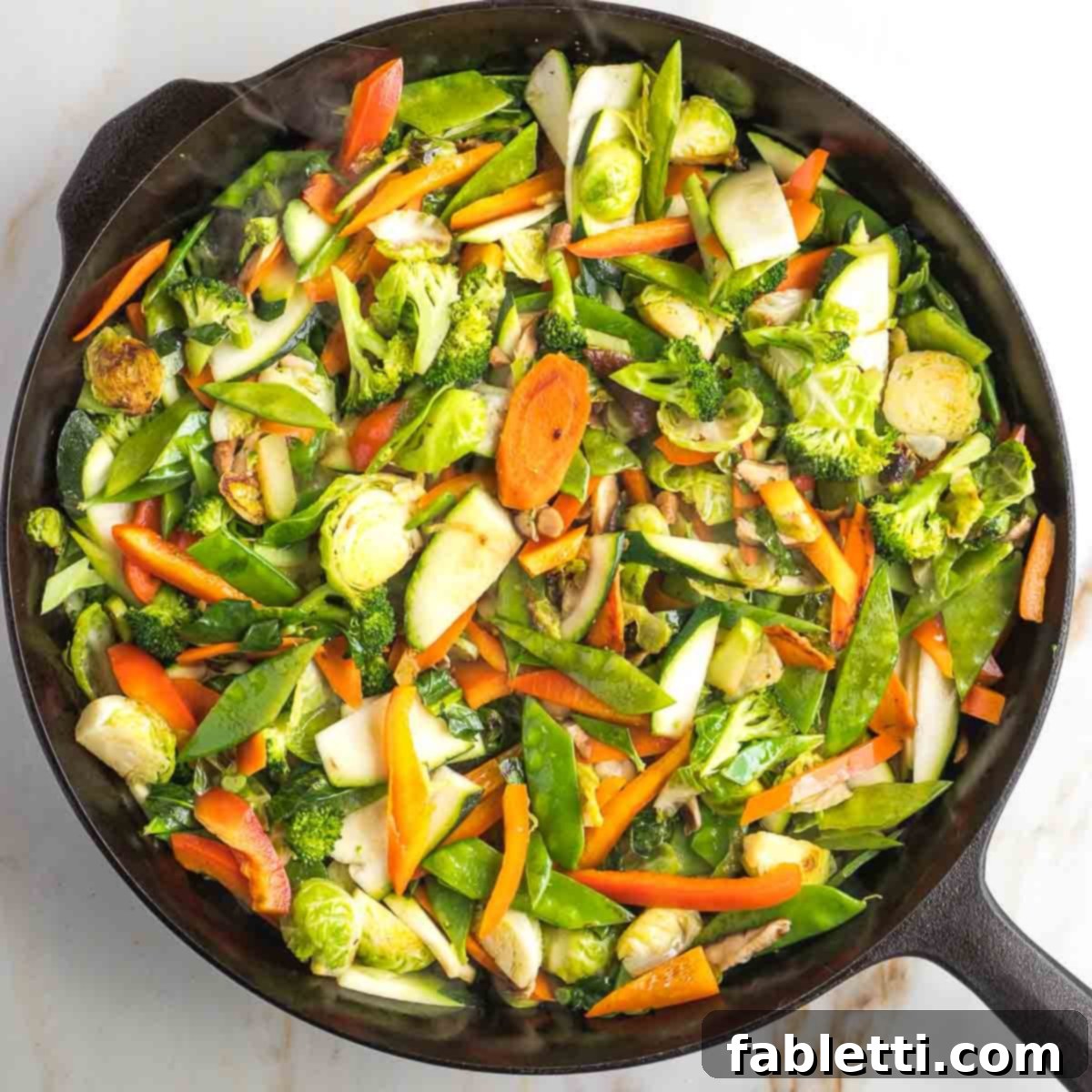
Reduce the heat to medium. Now, add the remaining vegetables: broccoli florets, sliced mushrooms, bell peppers, bok choy, and snow peas. Continue to cook and toss for approximately 4 minutes, or until the vegetables are tender-crisp (al dente) and brightly colored.
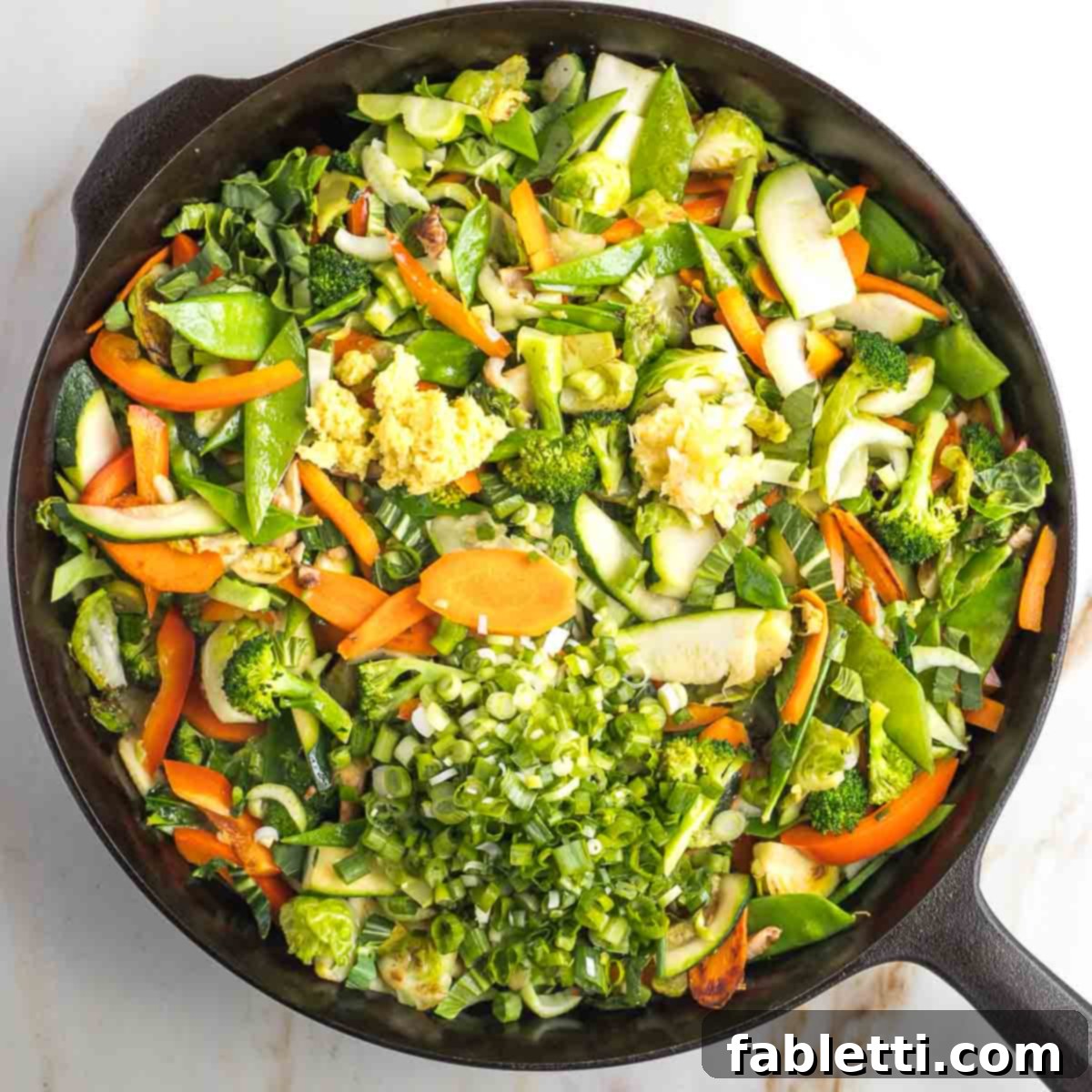
It’s time for the aromatics! Add the minced garlic, grated ginger, thinly sliced scallions, and the remaining toasted sesame oil to the pan. This will infuse the stir-fry with incredible fragrance.
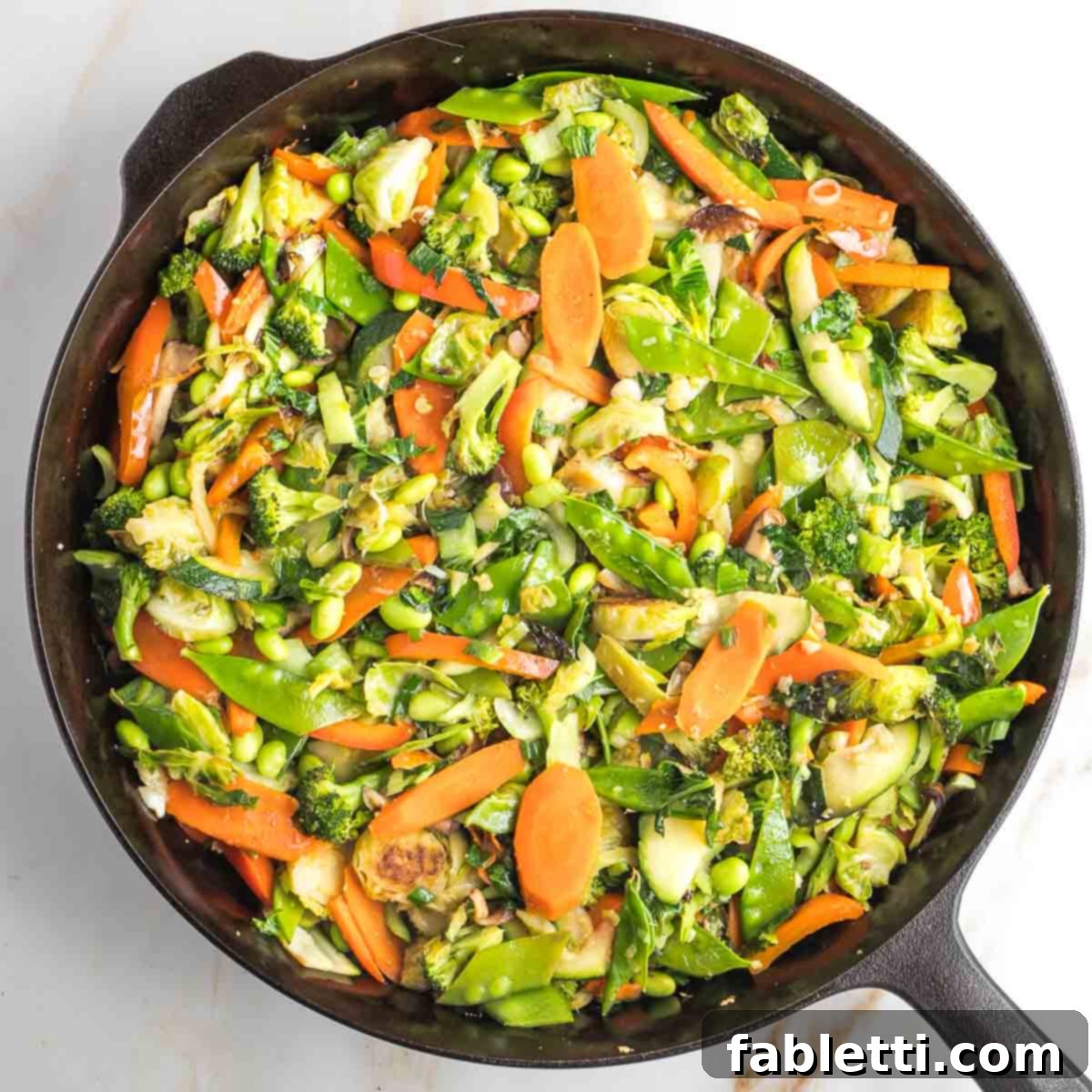
Stir and cook for about 1 minute until the aromatics are fragrant, being careful not to burn the garlic. Ensure they are evenly distributed among the vegetables.

Before serving, quickly reheat your prepared teriyaki sauce and give it a good whisk to ensure it’s smooth. Then, pour about half of the sauce generously over the finished vegetables in the pan.
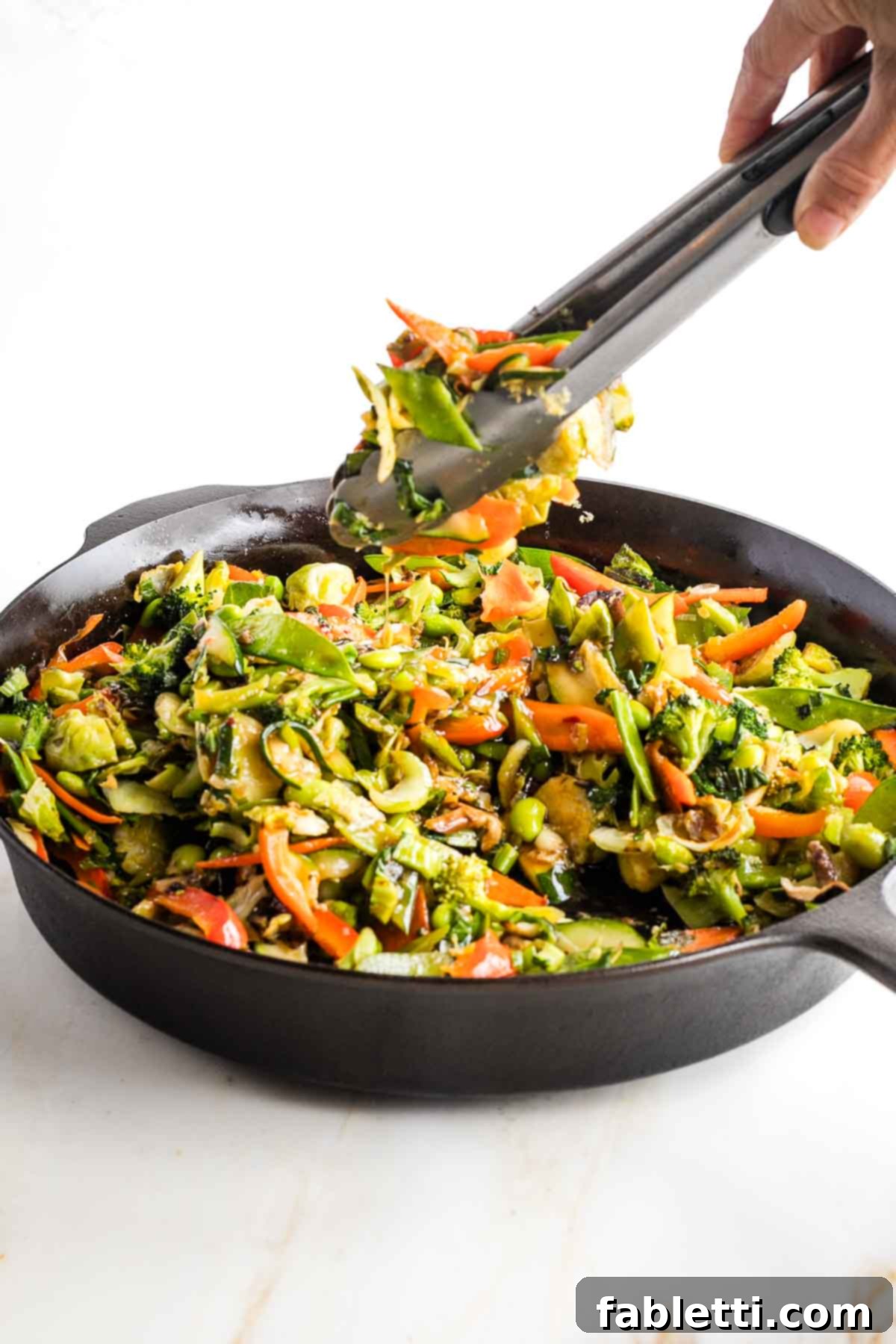
Use your tongs to gently mix the sauce thoroughly into the vegetables, ensuring every piece is coated. Add more sauce as needed to achieve your desired level of flavor and coverage.

Serve your delicious Teriyaki Stir Fry Vegetables immediately. For an added touch, sprinkle with toasted sesame seeds, a pinch of crushed red pepper flakes, and extra sauce if desired. Enjoy over your favorite grain or noodles!
What to Serve with Teriyaki Vegetables
Teriyaki stir-fry vegetables are incredibly versatile and pair wonderfully with a variety of sides to create a complete and satisfying meal. Here are some fantastic serving suggestions:
- Crispy Baked Tofu: For a protein-packed vegan meal, pair your stir-fry with perfectly crispy baked tofu. The contrasting textures and complementary flavors are a match made in heaven.
- Ginger Miso Slaw: A refreshing and tangy slaw with a ginger-miso dressing provides a cool, crunchy counterpoint to the warm stir-fry. It adds another layer of vibrant flavor.
- Brown Rice or White Rice: The classic pairing! Steamed brown or white rice provides a neutral base to soak up all that delicious teriyaki sauce. Brown rice adds a nutty flavor and extra fiber, while white rice is light and fluffy.
- Simple Cauliflower Rice: For a lower-carb or grain-free option, cauliflower rice is an excellent choice. It’s light, absorbs flavors beautifully, and keeps the meal feeling fresh.
- Rice Noodles or Ramen Noodles: If you prefer noodles over rice, toss your stir-fry with cooked rice noodles or gluten-free ramen noodles. This creates a hearty, slurpable meal that’s incredibly comforting.
- Quinoa: For an added protein and fiber boost, quinoa makes a great whole-grain alternative to rice. Its slightly nutty flavor complements the teriyaki sauce well.
- Spring Rolls or Edamame: Serve with a side of fresh spring rolls or a bowl of steamed edamame pods for an appetizer or extra veggie boost.
Expert Cooking Tips
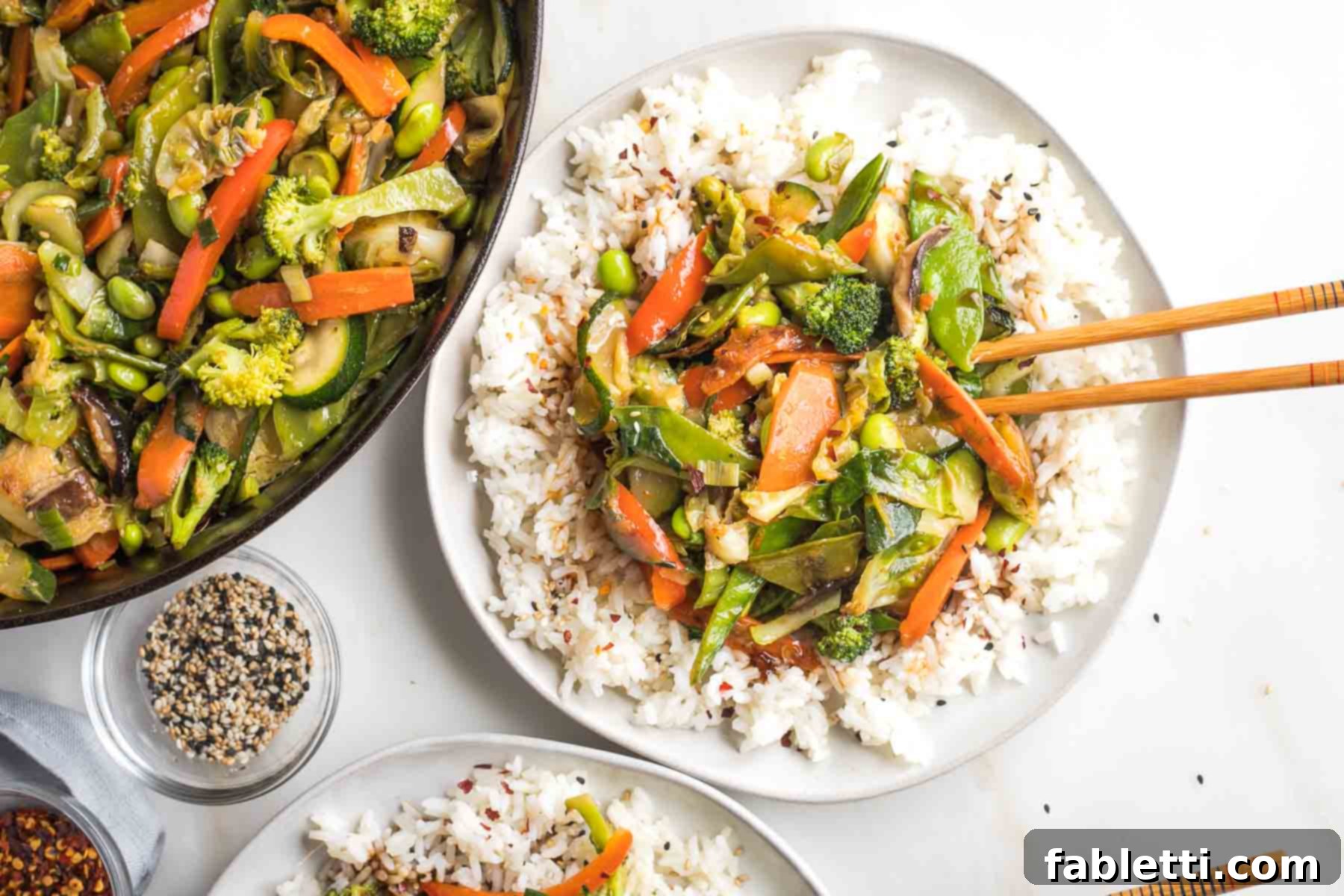
- Optimizing Leftovers with Rice: If you’re serving this delicious stir-fry over rice and anticipate leftovers, here’s a pro tip: mix any remaining cooked rice directly with the stir-fried vegetables before storing them in an airtight container. This simple step prevents the rice from clumping and becoming hard in the fridge, making it significantly easier to reheat and ensuring a much better texture when you enjoy your meal the next day.
- Layering Vegetables for Even Cooking: The secret to perfectly cooked stir-fry vegetables is understanding their individual cooking times. Always add harder or thicker-cut vegetables (like carrots, broccoli stems, Brussels sprouts) to the hot pan first, as they require more time to tenderize. Follow with medium-cooking vegetables (like bell peppers, mushrooms), and finally, add quick-cooking or delicate greens (like bok choy, snow peas, or spinach). Don’t stress too much about exact timing – it’s more about a logical progression than an exact science. The goal is for all vegetables to be tender-crisp at the same time.
- Don’t Overcrowd the Pan: For a truly excellent stir-fry, it’s crucial not to overcrowd your pan or wok. If you add too many vegetables at once, the temperature of the pan will drop rapidly, causing the vegetables to steam instead of stir-fry. This results in soggy, rather than crisp-tender, veggies. If you’re making a larger batch, cook the vegetables in two separate batches to maintain high heat and achieve that perfect texture.
- High Heat is Key: Stir-frying is all about quick cooking over high heat. Ensure your wok or large frying pan is very hot before adding any oil or vegetables. This high heat is what creates that desirable slightly charred, caramelized exterior while keeping the interior tender.
- Continuous Stirring: As the name suggests, “stir-fry” means active cooking. Keep the vegetables moving constantly with tongs or a stir-fry spatula. This ensures even cooking, prevents burning, and helps achieve that signature stir-fry texture.
- Taste and Adjust the Sauce: While the sauce recipe is balanced, individual preferences vary. Always taste the teriyaki sauce before adding it to the vegetables and adjust as needed. You might prefer a little more sweetness (add maple syrup), more tang (add rice vinegar), or a bit more spice (add red pepper flakes or sriracha).
Storage and Reheating
Proper storage and reheating are key to enjoying your delicious teriyaki stir-fry long after it’s initially prepared. Follow these guidelines to maintain freshness and flavor:
- Storing the Stir-Fry: Transfer any leftover stir-fried vegetables to an airtight container. They will keep fresh in the refrigerator for up to 5 days. If you have any extra homemade teriyaki sauce, store it separately in a clean glass jar in the fridge, where it will remain fresh for about a week.
- Reheating the Stir-Fry:
- Stovetop: For the best results and to restore some of that stir-fry crispness, reheat the leftovers in a skillet over medium-high heat. Stir occasionally until the vegetables are heated through, which usually takes 5-7 minutes.
- Oven: Alternatively, you can reheat the stir-fry in a 375-degree Fahrenheit oven for about 15 minutes, or until thoroughly warmed. This method is good for larger batches.
- Microwave: While convenient, microwaving can sometimes make the vegetables a bit softer. Heat in 1-minute intervals, stirring in between, until hot.
- Freezing the Sauce: Your homemade teriyaki sauce is freezer-friendly! Pour it into a freezer-safe container, ensuring there’s enough headspace for expansion as it freezes. It can be stored for up to 3 months. Thaw in the refrigerator, then give it a good shake or whisk before using.
- Freezing the Stir-Fry: The cooked vegetable teriyaki stir-fry can also be frozen in a freezer-safe container for up to 3 months. While it will still be safe to consume, be aware that the texture of some vegetables (especially softer ones like zucchini or mushrooms) might change slightly after freezing and thawing, becoming a bit softer. It’s still a convenient option for future meals.
- Meal Prep Tips: To make future stir-fry nights even quicker, chop all your fresh vegetables ahead of time and store them in an airtight container in the refrigerator for 2-3 days until you’re ready to cook. You can also prepare the teriyaki sauce in advance and store it in a glass jar in the fridge for up to a week. This way, dinner comes together in just minutes!
Did you enjoy this recipe? We’d love to hear from you! Comment below and consider leaving a five-star rating to support your favorite food bloggers. Don’t forget to share your culinary creations on Instagram by tagging @dkhealthcoach and using the hashtag #debraklein so we can see your delicious dishes!
📖 Recipe
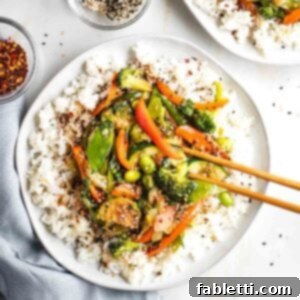
Teriyaki Stir Fry Vegetables
Author: Debra Klein
Teriyaki Vegetable Stir Fry is a quick and tasty answer to what’s for dinner. Delicious vegan teriyaki sauce is paired with stir-fry veggies for a great meal, even on busy weeknights.
Prep Time: 15 mins
Cook Time: 10 mins
Total Time: 25 mins
Course: Main Course, Side Dish
Cuisine: Asian
Servings: 4
Calories: 204 kcal
Equipment
- 1 Wok
- Chef’s knife
- Extra Large Bamboo Cutting Board
- Small Whisk
- Pyrex Glass Measuring Cup Set
- Microplane Grater
Ingredients
Teriyaki Sauce
- ⅓ cup Tamari (gluten-free soy sauce)
- 3 tablespoon unsweetened rice vinegar
- 2 tablespoon maple syrup
- 1 tablespoon arrowroot powder
- ½ teaspoon red pepper flakes (optional, for spice)
- ½ cup water (for slurry)
Stir Fry Ingredients
- 5 cups chopped mixed vegetables (e.g., broccoli, bok choy, mushrooms, snow peas, red bell pepper, zucchini, Brussels sprouts, carrots)
- 1 cup shelled edamame beans (frozen or fresh)
- 4 cloves garlic, minced or grated
- 2-inch piece fresh ginger, peeled and grated or minced
- 1 bunch scallions, thinly sliced
- 2 tablespoon toasted sesame oil (or preferred cooking oil)
Instructions
Teriyaki Sauce
- Whisk together the ½ cup water and arrowroot powder in a small bowl to form a smooth slurry.
- In a small saucepan over medium heat, combine the tamari, rice vinegar, and maple syrup.
- Whisk in the arrowroot slurry and red pepper flakes. Continue to whisk constantly for about 3 minutes as the sauce comes to a boil and begins to thicken.
- Remove from heat and set aside. The sauce will continue to thicken and develop a nice sheen as it cools.
Stir Fry
- Prepare your aromatics: Peel and mince the ginger and garlic. Thinly slice the scallions, separating the white and green parts if desired.
- Chop all chosen vegetables into uniform, bite-sized pieces. Remember to cut harder vegetables into smaller pieces or cook them first.
- Heat a large wok or your largest frying pan over medium-high heat until very hot. Swirl in 1 tablespoon of the toasted sesame oil.
- Add the hardest vegetables first (e.g., carrots, broccoli stalks, Brussels sprouts). Cook, tossing frequently with tongs, for about 2 minutes until slightly tender-crisp.
- Next, add the medium-cooking vegetables (e.g., broccoli florets, red pepper strips, mushrooms, zucchini, snow peas, edamame). Continue to toss and cook for an additional 4-5 minutes, until all vegetables are tender-crisp but still retain a slight bite (al dente).
- Add the minced garlic, grated ginger, thinly sliced scallions (white and green parts), and the remaining 1 tablespoon of oil to the pan. Reduce the heat to medium-low.
- Stir constantly for about 1 minute until the aromatics are fragrant, being careful not to burn the garlic. Ensure everything is thoroughly mixed. Turn off the heat.
- Reheat the teriyaki sauce if it has cooled, giving it a quick whisk to ensure it’s smooth. Pour about half of the sauce over the stir-fried vegetables.
- Using tongs, mix the sauce thoroughly into the vegetables until everything is well coated. Add more sauce if desired to achieve your preferred level of flavor.
- Serve immediately over steamed rice, brown rice, cauliflower rice, or noodles. Garnish with sesame seeds and additional red pepper flakes, if desired.
Notes
Chopped Veggies:
- Fresh Vegetables: Cut into bite-sized pieces. Any combination of broccoli, cauliflower, zucchini, bell peppers, mushrooms, Brussels sprouts, bok choy, carrots, snow peas, snap peas to equal approximately 5 cups works well.
- Frozen Vegetables: Choose your favorite medley. Ensure there isn’t any freezer burn or large clumps of ice. You can use them straight from the freezer to the pan.
Nutrition Information: Actual nutrition information will vary depending on the specific vegetables and ingredients you choose. The provided values are estimates.
Optional: Sprinkle with sesame seeds and more red pepper flakes for extra flavor and crunch, if desired.
Nutrition
Calories: 204 kcal
Carbohydrates: 22g
Protein: 9g
Fat: 10g
Saturated Fat: 1g
Polyunsaturated Fat: 3g
Monounsaturated Fat: 4g
Sodium: 1123mg
Potassium: 600mg
Fiber: 5g
Sugar: 9g
Vitamin A: 819IU
Vitamin C: 99mg
Calcium: 104mg
Iron: 2mg
The nutrition calculations were done using online tools. To obtain the most accurate representation of the nutritional information in any given recipe, you should calculate the nutritional information with the actual ingredients you used. You are ultimately responsible for ensuring that any nutritional information is accurate, complete and useful.
Did you make this recipe?
Please leave a review below, then snap a picture and tag me @dkhealthcoach or use hashtag #dkhealtcoach on Instagram so I can see it!!
